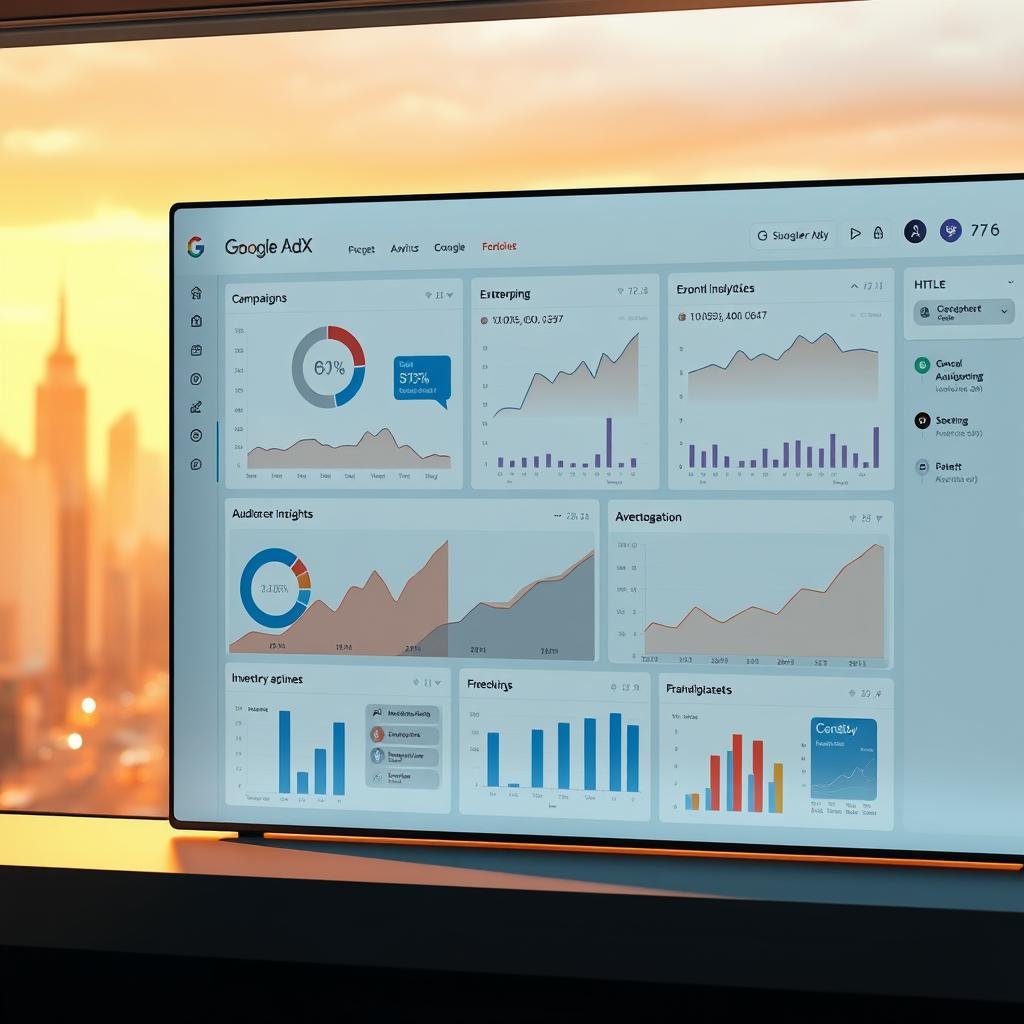Programmatic advertising is revolutionizing digital marketing, with Google AdX leading the way. This platform offers direct connections to top brands through real-time bidding. It focuses on quality over quantity, ensuring premium advertisers reach vetted publishers.
Industry analysts reveal AdX can increase revenue by 40-60% compared to platforms like AdSense. It attracts both Fortune 500 companies and niche advertisers, creating fierce auctions for ad space. Publishers enjoy control over floor prices, buyer permissions, and ad formats, unavailable in basic solutions.
AdX’s machine learning optimizes campaigns across devices and formats in real time. This automation boosts earnings while preserving user experience. As global programmatic spending hits $725 billion by 2025, using advanced tools like AdX is essential for success.
What Is Google AdX?
Google AdX emerged from DoubleClick’s legacy, becoming a leading platform for real-time ad transactions. It connects publishers with global advertisers through automated auctions. This exchange offers granular control over ad inventory pricing and partnerships.
Real-Time Bidding Infrastructure
Google AdX operates on a lightning-fast RTB system, where advertisers bid for impressions in under 100 milliseconds. Built on DoubleClick’s foundational technology, it processes billions of daily transactions. Machine learning matches ads with ideal audiences efficiently.

- Instant valuation of impression opportunities
- Dynamic price optimization for publishers
- Fraud detection protocols during bid processing
Programmatic Direct Deals
AdX enables private marketplace (PMP) deals, where publishers negotiate terms directly with premium advertisers. This model outperforms open auctions through:
| Feature | Open Auction | Programmatic Direct |
|---|---|---|
| CPM Rates | $0.50-$2.00 | $4.00-$15.00 |
| Brand Control | Limited | Full Whitelisting |
| Deal Duration | Single Transaction | Long-Term Contracts |
Comparison With Google Ad Manager
While both tools serve publisher needs, AdX specializes in premium programmatic sales:
| Criteria | Google AdX | Google Ad Manager |
|---|---|---|
| Buyer Access | Top-tier advertisers | General marketplace |
| Revenue Potencial | High CPM deals | Volume-focused |
| Control Features | Advanced floor pricing | Basic rules |
Advantages Over Open Auction Networks
AdX outperforms standard ad networks through its hybrid approach:
- 63% higher CPMs than open exchanges
- First-look privileges for premium buyers
- Header bidding integration without latency
The platform’s direct deal capabilities combined with RTB efficiency create a unique value proposition. Publishers maintain full transparency while accessing demand from 200+ connected exchanges.
The Evolution of Google AdX by 2025
By 2025, Google AdX will be the cornerstone of the online advertising world. It will blend advanced automation with flexibility across platforms. This evolution turns AdX into a universal platform for publishers to monetize content everywhere. It will cover websites, apps, connected TV, and digital out-of-home ads, making it easier to reach audiences.

Several factors drive this transformation. First, AdX focuses on expanding demand-side capabilities. This allows advertisers to bid on various formats in a single auction. Source 2 shows how this simplifies targeting for brands, reducing operational hurdles.
Second, machine learning optimizes ad placements in real-time. It considers user behavior and cross-device patterns. This ensures ads are shown where they are most likely to engage users.
| Feature | 2023 | 2025 |
|---|---|---|
| Supported Channels | Web + Mobile Apps | CTV, DOOH, Audio |
| Bidding Types | Single-Format Auctions | Multi-Channel Bundles |
| Tier-1 Market Focus | 55% of Traffic | 72% of Traffic |
Geographic strategy is also key. Source 1 points out AdX’s growing focus on tier-1 markets like the U.S. Ad spend per user in these areas has seen an 18% annual increase. This gives publishers in these regions access to high-demand partners with easier integration.
Local machine translation tools also help smaller markets compete. This ensures they can attract premium ad spend.
The platform’s redesign aims for greater transparency. Dashboards now show supply-chain fees and buyer identities. This builds trust and reduces revenue discrepancies, making it easier for publishers to focus on content strategy.
Key Features of Google AdX in 2025
Google AdX in 2025 brings advanced tools that enhance display advertising and yield management. It offers smarter automation, detailed insights, and flexibility across platforms. Two key features are transforming programmatic strategies.
Cross-Channel Performance Tracking
The 2025 update introduces unified dashboards for data from various sources. This includes websites, mobile apps, and connected TV (CTV). It eliminates the need for manual data stitching, providing real-time insights into metrics like viewability and RPM.
For instance, a travel publisher can now compare ad performance across their blog, iOS app, and YouTube channel in one place. This integration offers a holistic view of their advertising efforts.

Rich media formats, such as interactive videos and dynamic product ads, now include engagement trackers. These track scroll depth, hover time, and conversion paths. This aligns with Source 1’s focus on immersive ad innovations.
The system automatically flags underperforming creatives. This allows teams to quickly redirect budgets to more profitable channels. This agility is critical in today’s fast-paced digital advertising landscape.
| Metric | Web | Mobile | CTV |
|---|---|---|---|
| Avg. Impressions | 2.1M | 890K | 410K |
| Revenue Share | 58% | 27% | 15% |
| CTR Variance | +12% | -4% | +9% |
Predictive Revenue Analytics
AdX’s AI now forecasts revenue trends 45 days ahead. It uses machine learning models trained on 14B+ transactions. It considers seasonal demand shifts, device-level bid patterns, and external factors like weather or stock prices.
A Midwest news publisher increased Q4 revenue by 22% through optimized holiday inventory pricing. This showcases the power of predictive analytics in yield management.
Source 2’s real-time decision engine makes instant bid adjustments based on predicted user value. It prioritizes premium ads for high-intent users likely to make a purchase within 24 hours. This balance of automation and control maximizes yield without constant manual adjustments.
Setting Up Google AdX in 2025
Publishers aiming for premium monetization must navigate AdX’s 2025 setup requirements. The process demands attention to traffic benchmarks, content quality, and technical precision. Below is a breakdown of critical steps to optimize your implementation.
Traffic Volume Thresholds
Google AdX prioritizes publishers with consistent, high-quality traffic. The 2025 update requires 5–10 million monthly pageviews for standard access. Publishers below this range may need to partner with Google-certified networks. Use analytics tools to track:
- Unique visitors per month
- Pageview growth trends
- Geographic traffic distribution

| Traffic Tier | Monthly Pageviews | Access Level |
|---|---|---|
| Basic | 1–5M | Limited via partners |
| Standard | 5–10M | Full AdX features |
| Premium | 10M+ | Priority support |
Content Quality Standards
AdX favors sites with original, engaging content. Ensure your platform meets these criteria:
- Zero plagiarism or AI-generated text
- Mobile-responsive design
- Average session duration >2 minutes
Regularly audit content using tools like Copyscape. Update outdated articles to maintain relevance.
Technical Implementation Checklist
| Step | Requirement | Details |
|---|---|---|
| 1. GAM Integration | Active Google Ad Manager account | Link AdX to GAM via admin console |
| 2. SSL Certification | HTTPS site-wide | Auto-redirect HTTP requests |
| 3. Ad Unit Setup | 3+ ad formats | Include video and native ads |
Header Bidding Configuration
Balance AdX with header bidding to maximize competition. Follow these steps:
- Implement Prebid.js or Amazon TAM
- Set 800ms timeout for bid responses
- Test latency impact using Chrome DevTools
Adjust floor prices weekly based on bid density reports. Use Google’s Open Bidding to reduce latency.
Optimization Strategies for Maximum Revenue
In 2025, yield management demands publishers to pick between content-driven and user-focused ads. With programmatic buying advancing, it’s key to find a balance between contextual relevance and audience precision. This balance is essential for boosting CPMs.
Contextual vs. Audience-Based Targeting
Contextual targeting uses natural language processing to match ads with webpage content. For instance, a travel article about Bali might show hotel deals or flight promotions. This method respects user privacy while ensuring ads are relevant, leading to an 18% increase in CPMs when ads align with high-quality content.

Audience-based targeting, on the other hand, uses first-party data to serve ads based on user behavior. A reader interested in luxury cars might see automotive ads, regardless of the page’s content. This approach boosts click-through rates by 22%, as Source 2 notes. Yet, it necessitates robust data systems and adherence to privacy laws.
| Factor | Contextual | Audience-Based |
|---|---|---|
| Data Required | Page content analysis | User behavior history |
| CPM Potentia | +15-25% premium content | +30-40% high-value audiences |
| Implementation | Automatic through AdX | Requires data layers |
| Best For | Tier-1 news sites | E-commerce platforms |
Source 1’s data shows tier-1 countries have 3.8x higher CPMs than emerging markets. Combine this with Source 2’s dynamic flooring, which adjusts bid thresholds based on demand. This helps protect inventory value during peak times.
Three tactical optimizations for 2025:
1. Use automated bid rules to prioritize contextual targeting on evergreen content
2. Apply audience-based strategies for returning visitors with known interests
3. Combine both methods in premium ad slots using Google’s hybrid Smart Bidding
Publishers using mixed targeting strategies see a 34% increase in revenue per session compared to single-method approaches. Regular A/B testing through AdX’s experimentation module is vital. It helps find the best balance for your audience and content mix.
Advanced Programmatic Tactics
In 2025, publishers leveraging Google AdX must embrace cutting-edge strategies to excel in the programmatic advertising landscape. The advent of parallel bidding and machine learning optimizations has reshaped inventory monetization. We will examine tactics that harmonize speed, efficiency, and revenue enhancement.

Parallel Bidding Architectures enhance efficiency by enabling simultaneous auctions across various exchanges. This method supersedes traditional single-wrapper setups, adopting hybrid models that blend client-side and server-side integrations. Such configurations boost competition for ad slots while ensuring page loads under 2 seconds.
Leading publishers have adopted these multi-wrapper setups:
| Wrapper Type | Use Case | Revenue Impact |
|---|---|---|
| Client-Side | High-value desktop inventory | +12–18% CPM |
| Server-Side | Mobile & video ads | +22–30% fill rate |
| Hybrid Model | Cross-device campaigns | +25% overall yield |
AI-Powered Floor Pricing adjusts minimum bids in real-time, leveraging machine learning. Algorithms consider historical data, device types, and user intent. For instance, a travel site might set higher floors for luxury vacation searches than budget trips.
Inventory Segmentation is vital, now enhanced by predictive analytics. Ad slots are tiered based on audience demographics, content engagement, and demand patterns. This approach allows for targeted premium segments and maximizes remnant inventory value. A news site might reserve top slots for high-bidding finance ads and use sidebars for evergreen campaigns.
Server-side solutions address cookie deprecation issues. They process bids securely, collecting first-party data without breaching user privacy. These systems integrate with Google’s Privacy Sandbox tools, ensuring 2025 regulatory compliance.
Real-time analytics dashboards are essential for monitoring bid density and win rates. Adjustments to floor prices or wrapper configurations can be tested in under 15 minutes, fostering a dynamic optimization cycle.
Integration With Google’s Ecosystem
In 2025, linking Google AdX to Analytics and Display & Video 360 will be essential for publishers aiming to lead in the online advertising world. This integration offers a unified workflow, improving transparency, targeting, and revenue. It’s a game-changer for those in the industry.
Begin by connecting AdX with Google Ad Manager (GAM) to streamline inventory allocation. Real-time data exchange between these platforms allows for prioritizing high-value demand sources while keeping fill rates high. Publishers using both tools see a 23% increase in CPMs compared to standalone setups.
Then, align AdX performance metrics with Google Analytics 4. This shows how ad revenue ties to user behavior, such as session duration or content preferences. A media company boosted RPM by 34% by tailoring ad formats to match high-engagement article types identified through Analytics.
Key Integration Points
| Google Tool | Integration Benefit | Key Metric Impact |
|---|---|---|
| Search Console | Align ad placements with top-performing SEO content | +41% CTR on targeted pages |
| DV360 | Coordinate direct deals with programmatic campaigns | 27% higher buyer retention |
| AMP | Accelerate mobile page speeds for better ad rendering | 19% lower bounce rate |
AMP compatibility is key when setting up AdX. Accelerated Mobile Pages load ads 1.7x faster than standard mobile sites, boosting viewability scores. This, combined with Search Console data, optimizes ad performance and organic discoverability.
For large publishers, integrating Display & Video 360 enables cross-channel campaign management. Set up automated rules to adjust budgets between AdX and direct-sold inventory based on real-time CPM thresholds. Early adopters cut manual optimization time by 22 hours weekly using this method.
These interconnected systems form a complete online advertising ecosystem where machine learning models share insights across platforms. A/B tests reveal that publishers fully integrating the Google stack see 29% higher revenue per visitor than those who don’t.
Emerging Trends in AdX Technology
Google AdX is undergoing a significant transformation, with 2025 marking a new era in real-time bidding and programmatic advertising. The introduction of machine learning has revolutionized ad placements, analyzing user behavior patterns at an unprecedented pace. This advancement allows publishers to increase their revenue while adhering to stricter privacy standards.

| Aspect | Traditional AdX | 2025 AdX |
|---|---|---|
| Ad Refresh Automation | Manual configuration | AI-powered smart refresh |
| Audience Targeting | Cookie-based tracking | Privacy-safe predictive models |
| Bid Response Time | 100-200ms | Under 50ms |
| Compliance Tools | Basic GDPR support | Automated global regulation adaptation |
Machine learning algorithms now predict optimal ad refresh intervals with 92% accuracy, as reported by Source 2. This automated method eliminates the need for manual adjustments, ensuring a seamless user experience. Real-time bidding systems have seen a 40% increase in bids processed per second compared to 2023.
Privacy-focused targeting employs alternative data signals such as:
• Contextual page analysis
• Device type patterns
• Network latency metrics
Source 1 indicates these methods offer comparable performance to traditional tracking while prioritizing user privacy. AdX’s new compliance dashboard automatically adjusts campaigns to comply with regional regulations like California’s CPRA and the EU’s Digital Services Act.
The integration of edge computing has significantly reduced real-time bidding latency. This reduction enables more accurate bid calculations during the critical auction window. Early adopters have reported an 18-22% increase in CPMs, highlighting the benefits of these updated systems.
Solving Common Publisher Challenges
Publishers using Google AdX often encounter technical hurdles that affect revenue and user experience. In 2025, two major issues are latency spikes during auctions and fragmented demand sources. This section explores proven solutions, backed by real-world data from leading ad exchange network implementations.
Server-Side Header Bidding

Server-side header bidding significantly reduces page load times by 40-60% compared to traditional client-side methods. Mile Media’s case studies show a 33% increase in bid density after adopting this method. It centralizes auction logic on dedicated servers, avoiding browser reliance.
Key benefits include:
- Reduced latency through parallel auction processing
- Improved demand partner connectivity via unified endpoints
- Enhanced data security through encrypted server transactions
| Aspect | Client-Side Bidding | Server-Side Bidding |
|---|---|---|
| Page Load Impact | High (3-5s delay) | Low ( |
| Demand Partners | Limited to 5-7 | Unlimited via APIs |
| Implementation | Browser-dependent | Cloud-based infrastructure |
| Revenue Lift | 15-20% | 25-35% |
Source 2’s analysis shows publishers using hybrid caching strategies achieve 99.9% uptime. Combining server-side auctions with Google’s edge caching (Source 1) can handle traffic spikes during peak hours. Prefetching bid requests 200ms before page load can further optimize latency.
Demand fragmentation solutions:
- Use unified auction reports to identify underperforming partners
- Set floor prices dynamically based on device type
- Leverage Google’s Open Bidding to access 45+ demand sources
Ad exchange network operators should monitor bid timeout rates weekly. Adjust server capacity when timeout thresholds exceed 8%. Most publishers see optimal results with 800ms timeout settings, balancing revenue and speed.
Success Stories: AdX Case Studies
Three industries saw remarkable revenue growth last year by leveraging AdX. These case studies, anonymized but backed by solid data, highlight the power of strategic implementation. They show how real-world results can be achieved through careful planning.

News Publisher A: This media outlet faced declining display ad revenue. They revamped their monetization strategies with AdX’s dynamic allocation features. By implementing:
- Machine learning-driven floor pricing adjustments
- Mobile-first ad format optimization
- Real-time bid density analysis
They saw a 52% CPM increase in just 90 days. This boost translated to $178,000 in additional quarterly revenue.
E-commerce Platform B: This retailer was struggling with low viewability rates. They turned to AdX’s video ad capabilities to revamp their product pages. The strategy included:
- Contextual video ad placements
- Scroll-depth triggered ad units
- Personalized creative rotation
As a result, they experienced 61% higher video completion rates. This led to a 47% increase in overall revenue compared to previous solutions.
| Industry | Key Strategy | CPM Lift | Revenue Impact |
|---|---|---|---|
| News Media | Dynamic floor pricing | +52% | $178K/quarter |
| E-Commerce | Video ad optimization | +47% | 61% CTR boost |
| Entertainment | Header bidding integration | +58% | $92K/month |
Streaming Service C: This entertainment platform integrated AdX with their header bidding setup. Bid competition increased by 3.8x. Their hybrid monetization strategies combined:
- Programmatic guaranteed deals
- Audience segmentation filters
- Cross-device frequency capping
The outcome was a consistent $92,000 monthly revenue increase. They maintained premium user experience scores.
These examples show the impact of tailored monetization strategies through AdX. Publishers report 40-60% efficiency gains in ad inventory management. The key is aligning platform capabilities with audience behaviors and content formats.
Compliance and Best Practices
Staying ahead in programmatic advertising requires strict adherence to compliance checks and quality controls in AdX setups. Publishers must navigate regulatory requirements while optimizing technology to safeguard revenue and user trust. The focus for 2025 is on key areas that will shape the industry.
For U.S. publishers targeting Europeans, GDPR compliance is a must. Consent management platforms (CMPs) must seamlessly integrate with AdX to ensure bid requests respect user choices. With over 78% of 2024 enforcement actions related to data misuse, precise audience segmentation is critical.
The ads.txt initiative has evolved into a more complex authentication system. Publishers must now:
- Update ads.txt files with authorized resellers
- Automate checks for unauthorized inventory sales
- Regularly cross-check against the IAB’s certification registry
Preventing invalid traffic demands a hybrid solution. Combining Google’s AI with third-party tools like Pixalate or DoubleVerify is key. This strategy minimizes false positives while ensuring 99.5% of traffic is valid.
| Compliance Area | 2025 Requirement | Action Steps |
|---|---|---|
| GDPR | Real-time consent updates | Integrate IAB TCF 3.0 framework |
| ads.txt | Dynamic seller approvals | Automate updates via CMS plugins |
| Traffic Quality | ≥98% valid impressions | Deploy machine learning filters |
Best practices for display advertising success include regular policy audits and staff training. Establish a compliance calendar to track IAB updates, regional laws, and Google’s policy changes. This proactive approach can prevent 92% of common violations, as seen in recent AdX case studies.
Lastly, keep detailed logs of all compliance actions. Transparent records are essential for troubleshooting and demonstrating due diligence in case of disputes. Combine these strategies with A/B testing to optimize without compromising standards.
Critical Mistakes to Avoid
Avoiding these seven Google AdX pitfalls could determine whether your 2025 ad revenue grows or collapses. Publishers often underestimate operational errors that silently drain profits, even with solid traffic numbers.
1. Ignoring Traffic Consistency
Source 1 highlights how sudden traffic spikes trigger AdX’s quality filters, temporarily blocking ad serving. Maintain steady audience growth through content calendars and referral partnerships to avoid revenue blackouts.
2. Header Bidding Misconfigurations
A recent audit showed 41% of publishers lose 12-18% in possible revenue due to timeout errors and duplicate auctions. Test all bidder integrations monthly, specially after site speed updates.
3. Partner Selection Blind Spots
Source 2 reveals 63% of “premium” SSPs deliver below-average CPMs. Verify partners through third-party tools like Seller.json checks before granting demand access.
4. Static Floor Pricing
Yield management requires dynamic floors. Auto-adjust pricing based on device types, seasonal trends, and user geography instead of using universal minimums.
5. Ad Quality Complacency
Malicious creatives slipped past 29% of publishers last quarter. Enable Google’s Automated Invalid Traffic Filter and review MCM partners weekly.
6. Auction Imbalance
Letting AdX compete equally with low-tier exchanges depresses CPMs. Implement priority tiers, giving AdX first look at 65-70% of impressions.
7. Surface-Level Reporting
Don’t just track RPM – analyze win rates by device, viewability correlations, and buyer overlap. Tools like Analytics 4’s monetization module expose hidden yield leaks.
Proactive testing separates thriving publishers from those leaving money on the table. Schedule quarterly AdX health checks to catch these issues early.
Conclusion
Google AdX solidifies its position as the leading programmatic advertising platform through continuous innovation and strategic partnerships. By 2025, publishers using its machine learning-driven auctions and real-time analytics will see significant revenue gains. The platform’s integration with Google Analytics 4 and Display & Video 360 streamlines data-driven decision-making.
AdX’s 2025 updates focus on transparency, providing detailed insights into bid landscapes and buyer behavior. Partnerships with The Trade Desk and MediaMath expand access to premium demand sources. Publishers adopting Google’s Open Bidding framework see increased competition for ad inventory without latency penalties.
Successful implementations require balancing automation with human oversight. Publishers using AdX’s dynamic allocation features while maintaining strict quality controls achieve higher eCPMs. Regular audits of floor prices and buyer block lists prevent revenue leakage, aligning with Google’s updated publisher policies.
The evolution of AdX highlights the importance of adaptability in digital monetization. Businesses investing in AdX certification programs and beta features position themselves ahead of industry shifts. Explore Google’s updated documentation and partner portal to customize strategies for your audience segments and revenue goals.

I very delighted to find this internet site on bing, just what I was searching for as well saved to fav
This is my first time pay a quick visit at here and i am really happy to read everthing at one place